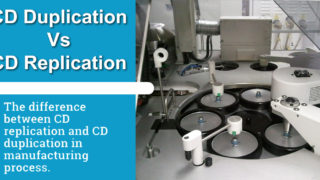Duplication Vs. Replication

What’s the Difference? Duplication Vs. Replication
Understanding the differences is important in determining which process is best for your project. A duplicated CD/DVD is not only created using a different process than a replicated CD/DVD, but the actual final product is also different.
There are two ways to make a copy of a CD or DVD. Information can be burned on to a blank CD/DVD-R; this method is called duplication. Information can also added during the CD/DVD manufacturing process; this method is referred to as replication.
Understanding the differences is important in determining which process is best for your project. A duplicated CD/DVD is not only created using a different process than a replicated CD/DVD, but the actual final product is also different. After the duplication process is complete, the final product is a CD-R or a DVD-R. Replication stampers for CDs produce CD-ROMs. (ROM means Read Only Memory). The final product in the DVD replication process is a DVD-5, DVD-9, DVD-10, or DVD-18.
The Processes
CD duplication is similar to burning a CD/DVD on your personal computer. A CD/DVD duplicator extracts data from the master disc and writes it to a blank disc. The difference between burning multiple CD/DVD-Rs at a duplication facility and burning one on your computer desktop is that the duplication facility burns hundreds at a time on towers that are linked together. Each tower contains several CD/DVD trays so that many copies can be created simultaneously. After all the data has been written unto the blank CD/DVD-R, the information is verified with the master, and the process is complete.
CD/DVD replicates, on the other hand, are created during the manufacturing process. In other words, media like a CD/DVD-R does not exist before the process starts. Before the replication process gets underway, the client master is painstakingly evaluated for data corruption. Then, a glass master containing relevant data from client supplied master is created. Replication begins when a flawless glass master is assured. The glass master is used to develop a stamper. The stamper, in turn, is loaded into an Injection Molding machine that creates CD/DVD replicates. The quality of CD replication hinges upon the quality of the glass master’s data. Through each successive step, quality and accuracy is consistently monitored to insure each disc is an exact replica or clone of the original. A layer of micro-thin aluminum is applied to the polycarbonate disc. It is then lacquered for additional protection and printed before packaging.
The client supplied master for CD-R and DVD-R duplication is the same, a CD/DVD-R. CD-ROM replication also requires a CD-R master. While a DVD-R is acceptable for DVD replication, most facilities prefer to work from a client supplied DLT or Digital Linear Tape.
Advantages of CD/DVD Duplication
1. The standard turn-time is 2-3 business days, even for runs up to 5,000 units.
2. Digital full color printing is available with no prepress charges.
Disadvantages of CD/DVD Duplication
1. The cost per unit for duplication is higher than replication.
2. DVDs can have up to 2 layers of information on each side of the media. DVD-R duplicates can have 1 layer of information on the entire DVD.
3. Most duplication facilities are small and are commonly limited to hand assembly of the media into packaging as a result of their low volume runs
Advantages of CD/DVD Replication
1. The unit costs are lower than duplicated discs.
2. Both offset printing and screen printing is available for replicated discs.
3. Replicated DVDs can contain 1 layer (DVD-5) of information, 2 layers on one side (DVD-9), 1 layer on each side (DVD-10) or 2 layers on each side (DVD-18). Many replication facilities are not yet set up for DVD-18 replication.
4. Most replication facilities, as a result of their high volume run capability, can auto assemble discs into jewel cases, paper/tyvek sleeves, amaray cases, or cardboard sleeves.
Disadvantages of CD/DVD Replication
1. The standard turn-time is 7-10 business days, longer for runs exceeding 100,000 units. Standard duplication turn times are 2-3 business days.
2. Most facilities have a minimum order requirement of 1,000 units.
Are There Noticeable Differences?
Both CD duplication and CD replication extract data from the original in the same way. In terms of manufacturing, however, this is where the similarities end. The finished product of either process performs in the same manner, although there will be difference to the eye depending upon the whether the discs are digitally, screened, or offset printed.
What About Special Circumstances?
The goals of every project are unique. Contact our customer service department to help determine which process best suits the requirements of your project..
